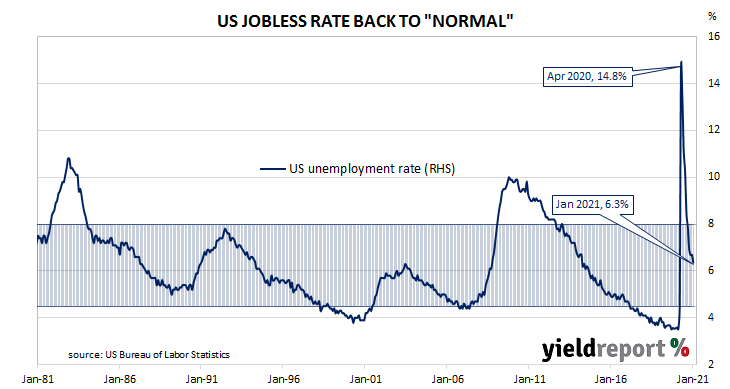Summary: January non-farm payrolls increase in line with expectations; November, December figures revised down; jobless rate drops considerably, participation rate falls; “not good news”, workers “discouraged”; jobs-to-population ratio up after pause; underemployment rate down again, half of April peak; COVID-19 still dragging on “self-sustaining recovery”.
The US economy ceased producing jobs in net terms as infection controls began to be implemented in March. The unemployment rate had been around 3.5% but that changed as job losses began to surge through March and April. May’s non-farm employment report represented a turning point and subsequent months provided substantial employment gains. Changes in recent months have been more modest and not always positive.
According to the US Bureau of Labor Statistics, the US economy created an additional 49,000 jobs in the non-farm sector in January. The increase was slightly under the 50,000 which had been generally expected earlier in the week but it was in contrast to 227,000 jobs which had been shed in December after revisions. Employment figures for November and December were revised down by a total of 159,000.
The unemployment rate dropped significantly, from December’s rate of 6.7% to 6.3%. The total number of unemployed decreased by 0.616 million to 10.130 million while the total number of people who are either employed or looking for work decreased by 0.405 million to 160.161 million. The fall in the number of people in the labour force led to a decline in the participation rate from December’s rate of 61.5% to 61.4%.
NAB currency strategist Rodrigo Catril said, “The unemployment rate unexpectedly fell to 6.3% from 6.7%, well below the consensus for an unchanged outcome, but this was not good news given the decline was largely explained by a pullback in the participation rate…meaning about 405,000 of workers left the market, a sign of discouragement.” ANZ Head of Australian Economics David Plank described the increase as “disappointing”.

Short-term US Treasury yields declined a while long-term yields moved a little higher on the day. By the close of business, the 2-year bond yield had slipped 1bp to 0.11% while the 10-year yield had gained 2bps to 1.17% and the 30-year yield finished 3bps higher at 1.97%.
One figure which is indicative of the “spare capacity” of the US employment market is the employment-to-population ratio. This ratio is simply the number of people in work divided by the total US population. It hit a cyclical-low of 58.2 in October 2010 before slowly recovering to just above 61% in late-2019. January’s reading increased to 57.5% after pausing at 57.4% for the previous three months.

